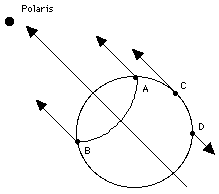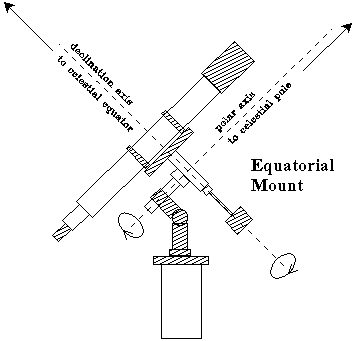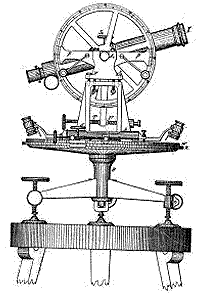(1)The Sky Above Us
The Firmament
Early starwatchers--especially the priests of Egypt and Babylon, semi-desert countries where skies are rarely clouded--were fascinated by the star-studded canopy which seemed to arch overhead, and by the daily cycle of the Sun, which seemed supernatural, beyond understanding. The ancient author of Psalm 19 wrote:
The heavens declare the glory of God,
And the firmament showeth His handiwork;
Day unto day uttereth speech,
And night unto night revealeth knowledge;
There is no speech, there are no words,
Neither is their voice heard.
Their line is gone out through all the earth,
And their words to the end of the world.
In them He has set a tent for the sun,
Which is like a bridegroom coming out of his chamber;
And rejoiceth as a strong man to run his course.
His going forth is from the end of the heaven,
And his circuit unto the ends of it;
And there is nothing hid from the heat thereof.
They noticed that the stars in that celestial canopy, the "firmament," maintained fixed patterns--constellations--night after night. Each culture gave them different names; the ones we use came from the Greeks and Romans--Big Bear, Big Dog, Scorpion, the Twins (a constellation with two evenly matched stars), and names from legends such as Orion, Cassiopeia, Perseus and Andromeda.
The Celestial Sphere
Throughout the night these patterns move, in general rising like the Sun in the east and setting in the west. It seemed to the early observers as if the stars were attached to the inside of an enormous hollow sphere with us in the middle, which slowly rotated, about one rotation a day.
Like a globe, the sphere of the sky has two points around which it turns, points that mark its axis --the poles of the celestial sphere. Stars near those poles march in daily circles around them, and the closer they are, the smaller the circles. At any time, only half the sphere is visible: it is as if the flat ground on which we stand sliced it in half--the upper half is seen, the lower half is not. Because of that, only one pole is seen at any time, and for most of us, living north of the equator, that is the north pole.
(If you mount a camera on a dark night in a way that the pole is in the middle of its field of view, open the shutter and take a time exposure, the image of each star will be smeared into part of a circle, and all the circles will be centered on the pole. Click here to see such a picture.)
The globe of the Earth has an equator around its middle, halfway between the poles. In a similar way, the sphere of the sky is circled by the celestial equator, halfway between the celestial poles. As the sky rotates, stars on the equator trace a longer circle than any others.
Of course, we know well (as the priests in Babylon didn't) that the stars are not attached inside a huge hollow sphere. Rather, it is the Earth which rotates around its axis, while the stars are so distant that they seem to stand still. The final effect, however, is the same in both cases. Therefore, whenever that is convenient, we can still use the celestial sphere to mark the positions of stars in the sky.
Polaris, the Pole Star
By pure chance, a moderately bright star is seen near the northern celestial pole--Polaris, the pole star (or north star). Polaris is not exactly at the pole, but its daily circle is very small and for many purposes one can assume it is at the pole, a pivot around which the entire sky rotates.

All this looks much clearer if one remembers that it is the Earth that rotates, not the sky. The axis around which the Earth spins points in a certain direction in the sky, and that is also the direction of the pole star (or more accurately, the northern celestial pole). As the Earth turns, even though the observer moves with it (for instance, from point B in the drawing to point A), that direction always makes the same angle with the horizon and is always to the north. Hence the pole star is always in the same spot--north of the observer, and the same height above the horizon.
If on a clear night you find yourself lost in the wilderness or at sea, the pole star can tell you where north is, and from that you easily deduce east, west and south. Any other star is unreliable for determining direction--it will move across the sky, and may even set--but not this one.
The closer you are to the equator, the closer is the pole star to the horizon, and at the equator (point C) it is on the horizon, and probably not easy to see. Further south, at points such as D, it is no longer visible, but now you can see the southern pole of the sky. Unfortunately, no bright star comparable to Polaris marks that position. The existence of a bright star near the north celestial pole is just a lucky accident, and as will be seen, it wasn't always so, and will not be a few thousand years from now.
The Mounting of a Telescope
As the drawing above makes clear, during the night we view the pole star from different positions (such as A and B). This however makes no noticeable difference in its place in the sky, because it is so distant from us. If the Earth rotated not around its axis but along a parallel line through A or B, the sky would not appear any different.
 |
The equtorial mounting of a telescope.
To track a star it is only necessary to rotate
!the telescope around its polar axis. |
To the eye the rotation of the sky is very, very slow (it is most noticeable when the Sun or Moon are rising or setting). A telescope however greatly magnifies the rotation rate, and any star observed with it quickly drifts to the edge of the field of view and then disappear, unless the direction of the telescope is constantly adjusted. That is usually done automatically, by turning the telescope around an axis parallel to the Earth's rotation, for as explained above, a parallel shift does not change the apparent rotation of the stars.
A surveyor's telescope ("theodolite"; see below) usually has two axes--one allows it to scan all horizontal directions over 360 degrees, while the other adjusts its elevation and allows it to set its sights on reference marks higher than the viewer, such as mountaintops. A telescope for viewing stars (above) also has two perpendicular axes, but the main one (the "equatorial axis") is slanted to point at the pole star and is therefore parallel to the Earth's axis. As the celestial sphere rotates, a clockwork (or in cheap telescopes, the hand of the observer on a suitable knob) turns the telescope at a matching rate, maintaining the same stars in the field of view.
 |
An old surveyor's tele-
scope (theodolite). |
Planets and the Zodiac
Not all stars keep fixed positions on the sphere of the heavens. Even early sky-watchers noted that a few moved about: the ancient Greeks called them "planets", wanderers. The names we use today came from the Romans, who named them after their chief gods--Mercury, Venus, Mars, Jupiter and Saturn.
Mercury and Venus are always close to the Sun and can only be seen shortly after sunset or before sunrise: Mercury is so close that most of the year it cannot be seen at all, because the bright sky drowns out its light. Venus is brighter than any other star (with appropriate conditions and looking right at it, you can see it even in the daytime) and Jupiter takes second place.
|